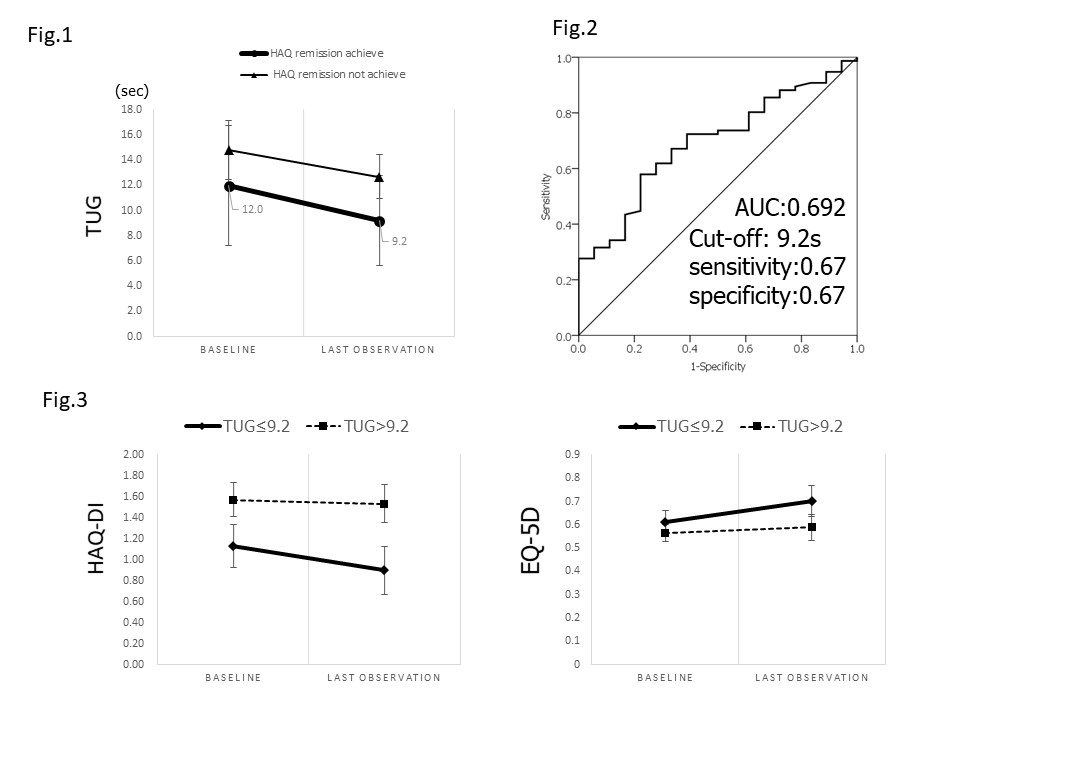Session Information
Session Type: ACR Poster Session A
Session Time: 9:00AM-11:00AM
Background/Purpose: Total management including reconstructive joint surgery and rehabilitation should be needed for further improvements of physical function for long-standing RA patients. It is very important to set treatment goal for those management. The purpose of this study is to set treatment target using Timed Up and Go test (TUG) in relation to achievement of HAQ-DI remission (HAQ-DI<0.5) with joint surgery in lower limbs.
Methods: Multicenter prospective observational cohort study was conducted among patients who underwent elective joint surgery for RA from April 2012 to March 2016 (Study registration: UMIN000012649). In this study, we collected data at baseline and at 6 or 12 months after the surgery. These data were as follow; age, sex, disease duration, drug therapies, and disease activity (DAS), TUG, and patient-reported outcome [HAQ-DI, EQ-5D (QOL), patientfs global assessment (PtGA) and BDI-II (depression)]. Correlation between TUG and other variables were determined. Association between TUG and achievement of HAQ remission and cut-off values for HAQ remission were also determined using logistic regression analysis with adjustment of age and sex and ROC curve, respectively.
Results: Totally, 139 patients with elective joint surgery in lower limbs were analyzed. Mean age, disease duration, HAQ-DI and TUG were 65.4 years, 17.5 years, 1.022, and 12.7 seconds, respectively. Elective joint surgeries were total hip arthroplasty; 10.1%, total knee arthroplasty; 33.8%, total ankle arthroplasty or ankle fixation; 10.1%, and forefoot arthroplasty; 46.0%. The surgeries can significantly improve the outcome measures, including TUG, DAS, PtGA, pain, EQ-5D and BDI-II other than HAQ-DI. In this study, 45 of 139 patients (32.4%) had HAQ remission status at baseline. 18 of 94 patients (19.1%) who had HAQ-DI>0.5 can achieve HAQ remission with the surgery. Notably, TUG at last observation was significantly associated with achievement of HAQ remission even after adjustment for age, sex, and DAS (1 second increasing of TUG. OR:0.72, 95% CI: 0.53-0.97). The adjusted-TUG at last observation of patients with achievement of HAQ remission was 9.2 second (95% CI: 5.6-12.8) (Fig.1). Cut-off of TUG at observation for achievement of HAQ remission was 9.2 second based on ROC analysis (Fig.2). Importantly, We confirmed significant more improving of EQ-5D,HAQ-DI and TUG in patients who achieved TUG 9.2 second at last observation than in patients who did not (Fig.3).
Conclusion: TUG was significantly associated with patient reported outcomes, HAQ-DI and EQ-5D. The cut-off values of TUG (9.2 seconds) should be important to achieve good QOL and physical function for patients with joint surgery in lower limbs and could be suitable target for surgical procedure.
To cite this abstract in AMA style:
Kojima T, Ishikawa H, Kojima M, Tanaka S, Haga N, Nishida K, Yukioka M, Hashimoto J, Miyahara H, Niki Y, Kimura T, Oda H, Asai S, Funahashi K, Ishiguro N. Setting Treatment Target for Joint Surgery in Lower Limbs in Patients with Long-Standing Rheumatoid Arthritis Based on Multicenter Prospective Cohort Study; Validation and Reliability of Objective Index of Activity Speed (Timed Up and Go test) for Measuring Physical Function [abstract]. Arthritis Rheumatol. 2018; 70 (suppl 9). https://acrabstracts.org/abstract/setting-treatment-target-for-joint-surgery-in-lower-limbs-in-patients-with-long-standing-rheumatoid-arthritis-based-on-multicenter-prospective-cohort-study-validation-and-reliability-of-objective-ind/. Accessed .« Back to 2018 ACR/ARHP Annual Meeting
ACR Meeting Abstracts - https://acrabstracts.org/abstract/setting-treatment-target-for-joint-surgery-in-lower-limbs-in-patients-with-long-standing-rheumatoid-arthritis-based-on-multicenter-prospective-cohort-study-validation-and-reliability-of-objective-ind/

